Tiger Salamander 101: Care Guide for the Beginner
by Janice Williams, PharmD
Introduction
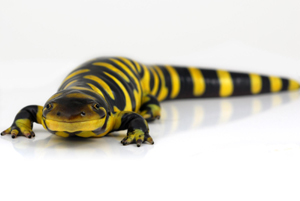
Ambystoma mavortium mavortium © John Clare
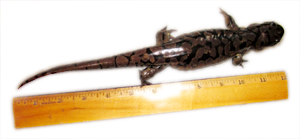
Adult tiger salamanders can grow over 1ft in length © Janice Williams
In the United States, a tiger salamander is often the first animal a new caudate enthusiast will acquire, perhaps because this salamander is the most ubiquitous, enjoying the widest range and distribution of all North American salamanders. As an enthusiast's first introduction to caudates, beginners often have many questions on how to care for these animals. The intent of this guide is to provide those answers. In developing this, I have called on my 50 intermittent years of practical experience with these wonderful, secretive creatures and the shared experiences of other knowledgeable enthusiasts. Although the information contained herein is tailored towards the tiger salamander, content describing care is also generally applicable to other commonly-kept fossorial Ambystoma species including the Blue-spotted (Ambystoma laterale), Spotted (A. maculatum), Jefferson's (A. jeffersonianum), and Marbled (A. opacum) salamanders. Recognize however, that the other species have differences in size, tendency to burrowing, and temperament/personality. I've limited the scope of this article to caring for adult salamanders, not larvae or eggs.
Legality: The first question that should be addressed before acquiring a salamander is whether or not acquiring and keeping the animal is legal. Regulations and laws vary from state to state and from country to country. In the U.S., regulations regarding caudates are usually found within each state government's Fish and Wildlife/Game departments and can be found by searching the state government's website.
Species: Tiger salamanders (Ambystoma tigrinum and Ambystoma mavortium).
Natural range: Found throughout much of the USA, southern Canada and eastern Mexico.
Size: 6 - 13 inches snout to tail length as adults.
Life span: If properly cared for and in good health, tiger salamanders can live 15 - 20 years in captivity.
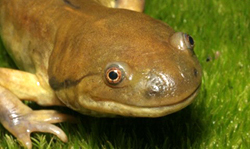
A. m. nebulosum, the Arizona tiger salamander
© Dick Bartlett
General appearance: The tiger salamander has a wide rounded snout with a stocky body and small protruding eyes. Coloration varies from black to olive-green to yellow. There are usually dark spots, blotches or vertical lines on a lighter olive color background or yellow spots or blotches on a dark-brown to black body giving it its "tiger" markings. It has a yellow underbelly irregularly splotched with darker colors or vice versa. Albino adults occur at very low frequencies. Pictures of the wide variety of colors and markings of the tiger salamander can be found on the A. mavortium page.
Temperament: Tigers tend to be bolder than other closely related species. Many tigers learn to 'recognize' their keeper and may 'beg' for food. Tigers are fossorial salamanders and are also known as mole salamanders due to their nature to burrow and/or live in underground burrows created by other animals.
Housing
Enclosure: Adult tiger salamanders can be maintained in a variety of enclosures. The simplest is a large plastic storage bin with a tight fitting lid that has been drilled with multiple small holes for ventilation. Alternatively, the salamander can be housed in an aquarium or other enclosure that allows for better viewing and aesthetics. A 10-gallon aquarium (50x25 cm) with a secure wire mesh top is adequate for one adult tiger salamander.
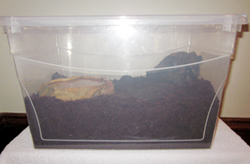
Plastic storage bin © Janice Williams
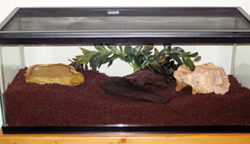
Glass vivarium with screen lid © Janice Williams
Two adults can be maintained in a 20 gallon-long aquarium (75x30 cm). Enclosure surface area (length x width) is more important than height. The main components of the enclosure are substrate, hiding places and a secure lid. Although tigers may not be the 'escape artists' that many newts and salamanders are, they can climb and because of their bulk and strength can push a lid off an enclosure, thus the need for a tight fitting lid.
Temperature: Tiger salamanders are easy to maintain from a temperature standpoint; they do well at temperatures that are considered 'average' room temperature (~72°F, 22°C) or cooler. They tolerate lower temperatures better than higher temperatures in captivity. High temperatures should be avoided; temperatures over 78°F (25.5°C) for extended periods of time are stressful and potentially life threatening.
Light: Data regarding the need for UV lighting are lacking. There is however, an association and some evidence to suggest that in some forms, such as black lights, sun lamps, direct sun light and experimental exposure to UVB, light may cause harm including eye and skin damage in some amphibians. Tigers do well with a photoperiod provided by a regular fluorescent light. In the home environment, exposure to ambient light during the day with no lighting at night works well. Enclosures should not be exposed to direct sun light.
Substrate tips
Substrates such as organic top soil without vermiculite, chemicals, fertilizer, pesticides, manure, etc. or coco-fiber or a mix of the two is recommended. Coco-fiber is sold as compressed blocks which must be reconstituted to form a moist fluffy substrate. Coco-fiber blocks are sold under such trade names as Bed-a-Beast and Eco Earth.
Peat moss or soil mixes containing peat moss should be avoided. Peat moss is acidic with a pH that can be as low as 3-4. Acidity can cause skin irritation and has the potential to produce ion exchange and electrolyte imbalance in the salamander, leading to illness and potentially death.
Gravel should not be used. Tiger salamanders lunge at their prey and can ingest small gravel in the process, leading to gut obstruction/impaction. There is no need for gravel in the enclosure but if used for drainage, it should be used as the lowest level of a multi-level substrate. Smooth rocks and stones can be used as decorations but should be larger than the size of the salamander's head to avoid accidental ingestion.
Cedar or pine bark, chips or mulch should never be used as a substrate because the oils in these woods can be toxic to amphibians.
Substrate: A good substrate should hold moisture to prevent desiccation of the salamander and allow for burrowing (see box for tips). The vivarium substrate should be able to break down organic matter such as feces, shed skin, and uneaten food. It must be able to maintain moisture without turning to mud, clumping, or drying out, and it should smell earthen and fresh. Substrates should not cause abrasion or irritation to the skin, which can potentially be a problem with jagged-edged wood chips or sharp bark slivers.
Optimally, substrate for the tiger salamander should be at least 4 inches (10 cm) in depth to allow for burrowing. Providing a moisture gradient will allow the salamander to self regulate and seek out an appropriate micro-environment. This is best accomplished by allowing one end of the enclosure to be less moist than the other end.
Hospital/Quarantine: For a hospital, temporary or quarantine
environment, tigers can be housed on paper toweling, unbleached or without
dyes preferably, moistened with either spring water or dechlorinated/deammoniated
water. Crumpled moistened paper toweling or a suitable structure should
be placed in the enclosure to provide for hiding places and reduce stress.
To prevent microbial contamination, paper toweling must be changed every
few days or when soiled.
Water: Untreated tap water should not be used in the care of caudates, as it may contain chlorine and/or chloramine which are toxic to amphibians.Sterile water, distilled water and de-ionized water also should not be used as these are hypotonic and can lead to electrolyte disturbances in the salamander. This is of special significance for aquatic or semi-aquatic caudates that actually live in water, but I empirically follow these guides in caring for tigers as well.
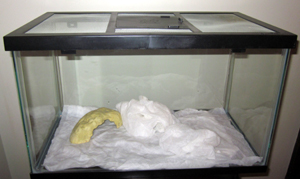
Quarantine setup with paper towel substrate
© Janice Williams
Environment: Tiger salamanders are fossorial animals and are nocturnal. They require a moist but not wet substrate to allow for burrowing, and they need places to hide. These are not the most visible of salamanders, as they spend most of their time underground in their burrows or under hides. Pieces of driftwood, large flat stones, cork bark and commercially available caves serve as excellent hides. Each adult animal should have at least one large hide. Based on personal experience, if a hole with an entrance is dug underneath a large flat hide or heavy water dish and the salamander introduced to this 'cave', it will remain and/or return there making locating the animal much easier. Fake silk or plastic plants can be added to make the vivarium more attractive. Live plants do not work well with tigers because these salamanders dig and plants can be easily uprooted. A shallow heavy water dish can be provided, but is not required. Some tigers appear to seek a water dish to take an occasional 'dip,' and a water bowl may provide a retreat for the salamander if the substrate becomes too dry or otherwise unsuitable. Fresh water should be placed in the dish every few days or when soiled by feces or substrate.
Ventilation: It is essential that the enclosure be well ventilated. If using an aquarium, a wire mesh top provides good ventilation. To provide adequate ventilation when using a plastic bin, multiple small holes should be drilled or melted with a hot glue gun into the container top and/or sides. If the enclosure is not well ventilated, an overly damp environment can ensue; such conditions may allow for the development of skin infections and other problems.
Maintenance: The vivarium should be spot cleaned several times per week to remove uneaten food, shed skin and feces. Feces look like brown football-shaped pellets around 1 inch (2 cm) in length and often contain indigestible parts of feeder insects. The substrate should be misted with water when it appears to be losing moisture. Misting frequency depends on several factors, such as the moisture retentiveness of substrate, ambient temperature, humidity, etc. Misting once or more per day may be required in arid areas, whereas in humid climates, misting may only need to be done once weekly or less. There is no guideline other than when the substrate looks dry, mist it. In all cases however, do not overwater.
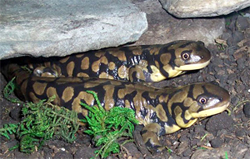
Ambystoma tigrinum ©2005 Mark Sobczak
The substrate should never be wet, only moist. Periodically the substrate will need to be changed. How frequently this is done is often dependent on the type of setup being used and whether there is an active ecosystem established in the vivarium. My preference is to clean the vivarium and replace the substrate about every two months. For this reason, I choose simple set-ups instead of elaborate decorative set-ups. A definite indicator for substrate change is a foul or sour odor. Another indicator of the substrate needing replacement, in my opinion, is the emergence of fungus gnats. These small, grey/black flies look somewhat like tiny mosquitoes without the proboscis. Although these flies are not harmful to salamanders, they can be bothersome to humans, especially when they escape the enclosure and invade human living spaces.
When cleaning the enclosure prior to replacing substrate, I use very warm tap water and scrub the interior with a sponge, rinse with cold water and then dry. I do not use soaps or detergents. If these products are used, the enclosure must be thoroughly rinsed and re-rinsed and dried before adding substrate. Any equipment such as buckets, sponges, etc., that I use in caring for tigers are not used for any other function. The equipment is theirs and theirs alone. When cleaning the enclosure I also scrub, rinse and dry any other items used in the vivarium such as hides, water dishes, fake plants, etc.
Generally, there is no need to disinfect an established vivarium, cleaning will suffice. In the event that disinfection is required, such as with an infectious outbreak, guidelines for disinfection should be followed; see Quarantine and Disinfection.
Increasing the Calcium Content of Prey
Crickets and most other feeder insects are poor sources of calcium. Two methods of enhancing the calcium content of crickets are gut-loading and dusting.
Gut loading is accomplished by feeding crickets a diet enriched with vitamins and high in calcium. There are a variety of commercial and homemade formulations that can be used. When gut loading crickets, the gut loading process should start 48 hours or more prior to feeding the salamander. This will often result in the death of many crickets, as they do not tolerate high calcium loads. Crickets begin to lose calcium in their feces quickly and thus should be consumed within a few hours of offering to the salamander.
The other method is to dust crickets with a good quality vitamin/mineral product in addition to a calcium preparation, such as Herptivite multivitamins plus Rep Cal's Calcium with Vitamin D3 or other preparations with similar vitamin/mineral content. These supplements should be stored in a cool dry area and replaced every six months once opened due to vitamin degradation.
Crickets should be dusted directly prior to feeding the salamander as the dust will be lost through movement and when crickets groom themselves. A simple way to dust crickets is to place them in a small plastic bag with the vitamin and calcium supplement, close the bag and shake a few times; the crickets will be covered with a thin layer of powder. Frequency of dusting is empirical but commonly keepers will feed dusted prey from one to two times per week.
Diet: Tiger salamanders are carnivores and will eat just about any type of prey they can fit in their mouths. They are attracted to food by the movement of the prey and will generally ignore dead prey and food pellets. In captivity they can be fed earthworms, crickets, roaches, and a variety of other invertebrates. Earthworms and night crawlers provide the perfect food for salamanders due to their nutritional content and optimal calcium to phosphorus ratio. If feeding a small tiger, night crawlers may need to be cut into pieces. Watching a tiger eat a worm is like watching someone 'slurp' a piece of spaghetti. Eating a whole night crawler may take the salamander a few minutes to accomplish and will usually involve robust thrashing of the worm.
Red wiggler worms may also be used. These small earthworms grow to about 2 inches (5 cm). Although nutritious, these may be unpalatable, as they exude a foul-smelling yellow liquid when chopped. They work well when they can be fed whole.
Crickets are a poor source of calcium with a low calcium-to-phosphorus ratio; if fed 'as is' and as the sole food source, this imbalance may lead to metabolic bone disease in the amphibian. Therefore, feeder crickets should either be gut loaded or dusted before feeding to the animal.
Tigers may also occasionally be offered pinky mice. However, these salamanders can and do become obese fairly easily. Thus pinkies and wax worms, which are high in fat and have a poor calcium to phosphorus ratio, should be fed rarely and perhaps only to fatten a thin tiger. Phoenix worms are also high in fat content, but have a good calcium-to-phosphorus ratio.
After eating, tigers may make facial gyrations, squeeze their eyes shut or appear to yawn. This is nothing to be concerned about. These movements appear to help the tiger move their food down the digestive tract. Tigers do not chew their food but rather swallow it whole.
How Often and How Much to Feed: When the vivarium is maintained around 72°F (22°C), tiger salamanders will need to be fed two to three times a week. The lower the temperature, the less often the salamander will need to be fed; if the enclosure is maintained at 60°F (16°C) or less, feeding once a week may suffice. I've noticed that in the winter months, even when the enclosure is maintained at room temperature, tigers often have a decreased appetite.
A general guideline is to offer the salamander as much as it will eat in several hours if using a food dish for worm pieces, phoenix worms, wax worms etc., or if allowing prey such as crickets to roam free in the tiger's enclosure. It is especially important to remove all uneaten crickets, as crickets can bite and potentially harm the salamander if left in the vivarium too long.
If hand feeding, I usually offer as much as the salamander will eat in 10 minutes or so. I prefer to feed by hand, as it allows me to know precisely what the salamander has consumed. Long tongs or tweezers can be used to hand feed, or the food item can be held and dangled from your fingers. For crickets and other large insects, I find that holding the cricket by one back leg and placing it close to the salamander's head elicits a feeding lunge and works well. I never move salamanders from their enclosure into another container to feed. In my opinion, there is no need to do this, as it causes undue stress and unwarranted handling.
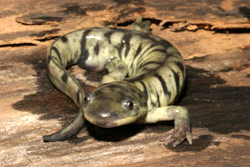
Arizona tiger salamander © Dick Bartlett
Handling: As with all amphibians, a tiger salamander's skin is semi-permeable and very sensitive to the environment. Because of this, the oils, salts and other chemicals that may be on our hands can be harmful to the salamander. It is recommended to handle these animals as little as possible and to wash and thoroughly rinse hands before handling the salamander and any vivarium accessories. Directly before picking up the tiger, hands should be wetted using spring or treated water. If placing the salamander into a container different than its vivarium (e.g., when cleaning the enclosure), the container floor should be wetted with spring or treated water to a depth of 1/4 inch (0.5 cm) or less, or moistened paper toweling should be placed on the bottom of the container.
Sexing: Sexing is best accomplished by observing the cloaca during breeding season; the adult male's cloaca is larger than the adult female's cloaca. Apart from satisfying curiosity, there is little practical application for determining sexes, in that tigers are notoriously difficult to breed indoors in captivity. For further information on sexing caudates, please refer to Sexing in Caudates.
Commonly Asked Questions
Can I keep him in a semi-aquatic tank? By nature, adult tiger salamanders will not be found in water except during breeding season and then in vernal pools. There is no need to have an aquatic section of the vivarium, and to do so increases the potential of drowning as adult tiger salamanders are poor swimmers. There is also anecdotal evidence that suggests that tiger salamanders kept in semi-aquatic setups are more prone to disease.
Does he need a friend? Salamanders are solitary animals except during breeding season. They do not get 'lonely' and get along very well as a sole animal. Tigers can be housed together given that there is adequate space, i.e., the equivalent surface area of a 20 gallon-long (75x30 cm) aquarium for two adult tigers, that the animals are of similar size, and that pathogen concerns have been minimized and quarantine procedures undertaken as necessary. Because tiger salamanders can be aggressive and even cannibalistic, it is not recommended to house small tigers with larger tigers. Even when tigers are of the same size, accidents may occur. Overzealous feeding responses can lead to nipping of tank mates' tails and toes.
Can he bite? Not intentionally or out of aggression. However, an overzealous feeding response may cause a tiger to mistake a finger for moving prey. They have rows of teeth on the bottom and top jaws consisting of short, sawtooth-like ridges used for gripping prey. I have been 'nipped' many times. It doesn't hurt and feels like sandpaper. I have heard anecdotal reports however, of tigers' bites drawing blood.
Can he make sounds? Salamanders, with little exception do not produce vocalizations due to the lack of vocal chords/sacs. However, sometimes when disturbed or picked-up, my tigers make a squeak-like noise. It is thought that these noises are produced from air being forced through the nares.
Does he shed? Tigers shed the outer most surface of their skin periodically, especially during growth. Like other caudates, they will often eat their shed. Eating the shed provides a source of moisture and nutrients and is nature's way of conserving both. If seen, the shed appears as a very thin film sort of like thin plastic wrap. I have found shed in water bowls and on the substrate surface, where if not removed it will harden.
Don't I need a water bowl in the enclosure so he can drink? Tiger salamanders do not drink water using their mouths. Rather they receive moisture and hydration from the water content of prey and from the environment through their semi-permeable skin. Skin absorption reinforces the need for a moist substrate at all times.
Additional Reading
Wright, KM and Whitaker, BR. 2001. Amphibian Medicine and Captive Husbandry. Malabar: Kreiger Publishing.
Petranka, JW. 1998. Salamanders of the United States and Canada. Washington: Smithsonian Institution Press.
Caudata Culture Resources
Species Information for Ambystoma tigrinum and Ambystoma mavortium
Food Items for Captive Caudates
Don't Do This! Captive Care Catastrophes
Article © 2011 Janice Williams.
